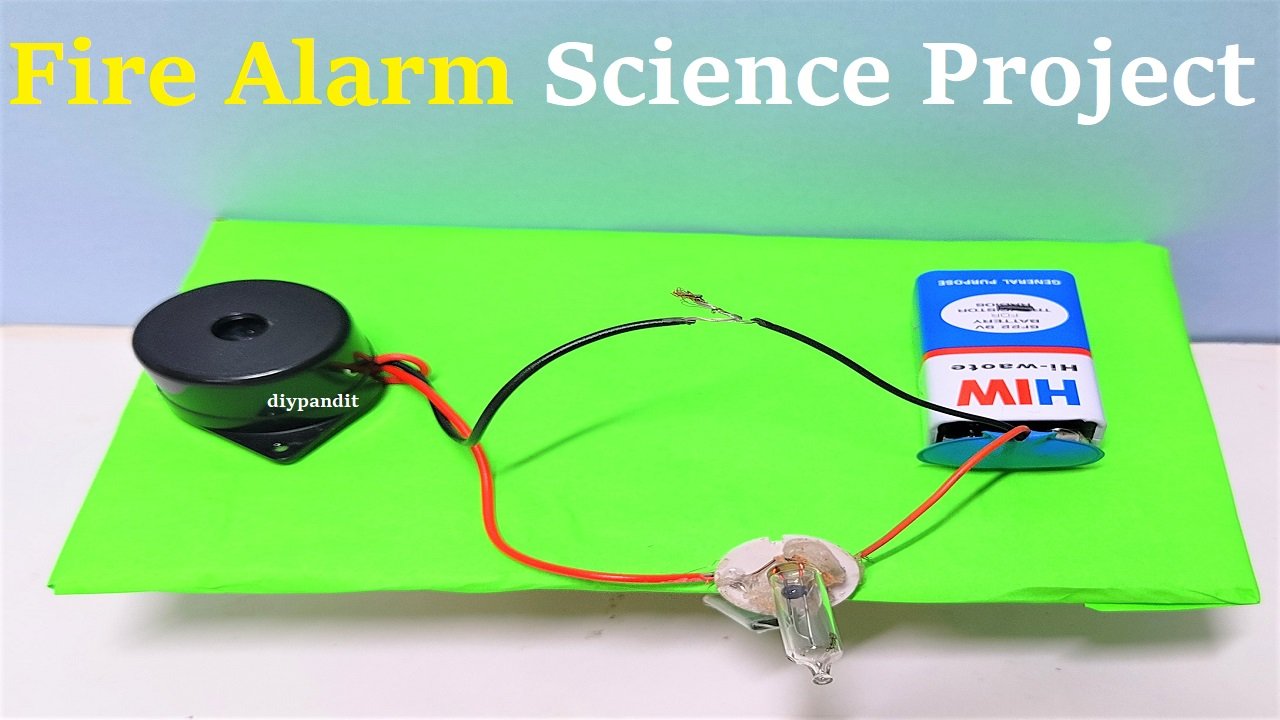Creating multiple working models of alarm systems can be a great way to explore different applications and principles behind alarms.

Here are 15 ideas for alarm-based science projects, each demonstrating a unique aspect or application of alarm systems:
1. Door Alarm System
- Objective: Create an alarm that sounds when a door is opened.
- Components: Magnetic reed switch, buzzer, battery, wires.
- Description: Install a reed switch on the door and frame. When the door opens, the circuit closes and triggers the buzzer.
2. Fire Alarm System
- Objective: Simulate a fire alarm using a heat sensor.
- Components: Thermistor (temperature sensor), buzzer, battery, wires.
- Description: Connect the thermistor in a circuit. When the temperature rises, the resistance changes, activating the buzzer.
3. Water Level Alarm
- Objective: Sound an alarm when water reaches a certain level.
- Components: Water level sensor, buzzer, battery, wires.
- Description: Use the water level sensor to detect high water levels and activate the alarm.
4. Intruder Alarm with Motion Sensor
- Objective: Detect motion and trigger an alarm.
- Components: PIR (Passive Infrared) sensor, buzzer, battery, wires.
- Description: Set up the PIR sensor to detect motion within a certain range and sound the buzzer when movement is detected.
5. Pressure-Sensitive Alarm
- Objective: Trigger an alarm when pressure is applied.
- Components: Pressure sensor or switch, buzzer, battery, wires.
- Description: Place the pressure sensor under a mat or object. When weight is applied, the circuit closes and activates the alarm.
6. Light-Sensitive Alarm
- Objective: Sound an alarm when light levels change.
- Components: LDR (Light Dependent Resistor), buzzer, battery, wires.
- Description: Set up the LDR to detect changes in light intensity. When light levels drop or increase, the buzzer sounds.
7. Smoke Detector Alarm
- Objective: Simulate a smoke detector.
- Components: Smoke sensor (e.g., MQ-2), buzzer, battery, wires.
- Description: Use the smoke sensor to detect smoke particles. When smoke is present, the alarm is triggered.
8. Gas Leak Alarm
- Objective: Detect gas leaks and sound an alarm.
- Components: Gas sensor (e.g., MQ-6), buzzer, battery, wires.
- Description: Set up the gas sensor to detect hazardous gases. When gas is detected, the alarm sounds.
9. Flood Alarm
- Objective: Detect flooding and trigger an alarm.
- Components: Float switch or water sensor, buzzer, battery, wires.
- Description: Place the float switch in a basin. When water rises and lifts the float, the circuit closes and the alarm sounds.
10. Personal Safety Alarm
- Objective: Create a portable alarm for personal safety.
- Components: Small switch or pull-pin, buzzer, battery, wires.
- Description: Construct a small, wearable device. When the switch is activated or the pin is pulled, the alarm sounds.
11. Carbon Monoxide Detector Alarm
- Objective: Simulate a CO detector.
- Components: CO sensor, buzzer, battery, wires.
- Description: Use the CO sensor to detect carbon monoxide levels. When CO is detected, the alarm is triggered.
12. Proximity Alarm
- Objective: Sound an alarm when an object is too close.
- Components: Ultrasonic sensor, buzzer, battery, wires.
- Description: Set up the ultrasonic sensor to detect objects within a certain range. When an object gets too close, the buzzer sounds.
13. Temperature Alarm
- Objective: Trigger an alarm when temperature exceeds a threshold.
- Components: Temperature sensor, buzzer, battery, wires.
- Description: Use the temperature sensor to monitor ambient temperature. When it exceeds the set threshold, the alarm is activated.
14. Step-On Alarm Mat
- Objective: Detect when someone steps on a mat.
- Components: Pressure mat, buzzer, battery, wires.
- Description: Place the pressure mat in a specific area. When someone steps on it, the circuit closes and the alarm sounds.
15. Vibration Sensor Alarm
- Objective: Sound an alarm when vibrations are detected.
- Components: Vibration sensor, buzzer, battery, wires.
- Description: Attach the vibration sensor to an object or surface. When vibrations are detected, the alarm is triggered.
These working models of alarm systems can be used to explore different types of sensors and their applications, as well as the basics of electrical circuits and alarm mechanisms. Adjust the complexity and materials based on the grade level and resources available.

